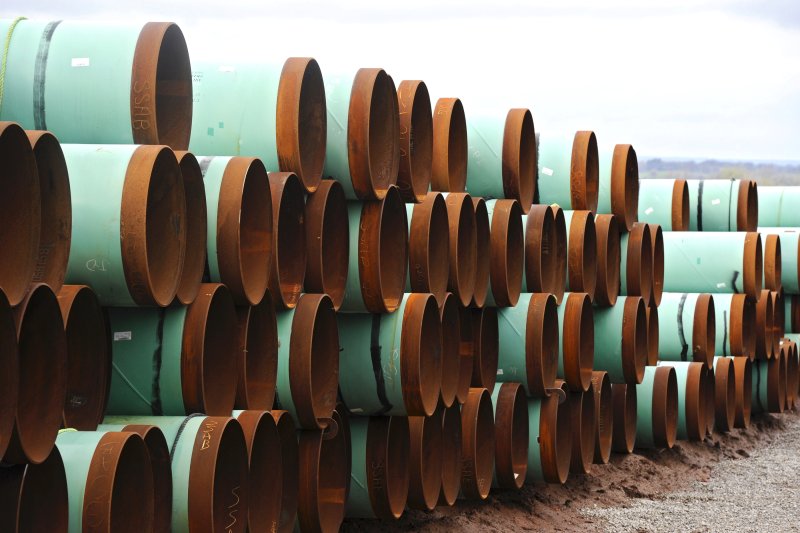epa05747105 (FILE) - A file picture dated 21 March 2012 shows piping to be used for the Keystone XL pipe line from Cushing, Oklahoma to the Gulf of Mexico, as they sit stacked at a storage yard in the TransCanada Pipe Yard near Cushing, Oklahoma, USA. US President Trump on 24 January 2017 signed an executive order that allows the disputed Dakota Access and Keystone XL pipelines, under the precondition that US-American steel was used. Former president Obama's administration in 2015 halted the controversial Keystopne XL project. EPA/LARRY W. SMITH
March 30 (UPI) -- President Donald Trump has signed a permit that allows for construction of the Keystone XL oil pipeline and a facility in Montana as work has been delayed because of a federal court order.
In the presidential decision Friday, the permit authorizes TransCanada Corp., subject to certain conditions, to "construct, connect, operate, and maintain pipeline facilities at the international boundary between the United States and Canada for the import of oil from Canada to the United States."
Last November, U.S. District Court Judge Brian Morris invalidated an earlier permit in a lawsuit filed by three Native American tribes in Montana and South Dakota. The ruling is being appealed in the 9th Circuit.
"For the avoidance of doubt, I hereby revoke that March 23, 2017, permit," Trump wrote in Friday's order.
Trump, in an executive order, previously reversed former President Obama's 2015 denial of the pipeline permit. The pipeline was first proposed more than 10 years ago under President George W. Bush.
TransCanada Corp. wants to build a 1,184-mile pipeline that would move 800,000 barrels of crude oil daily from Alberta, Canada, through the Central Plains to the Gulf Coast. A presidential permit is needed because the 36-inch pipe moves across state borders.
"President Trump has been clear that he wants to create jobs and advance U.S. energy security and the Keystone XL pipeline does both of those things," Russ Girling, TransCanada's president and chief executive officer, said in a statement. "We thank President Trump for his leadership and steadfast support to enable the advancement of this critical energy infrastructure project for North America.
"The magnitude of the work on this project has been extensive. The Keystone XL pipeline has been studied more than any other pipeline in history and the environmental reviews are clear -- the project can be built and operated in an environmentally sustainable and responsible way."
TransCanada has more than 57,500 miles of gas transmission networks across North America.
The XL Pipeline has been criticized for its possible environmental impact.
The pipeline route would cross the Milk River, west of Nashua, and the Missouri River -- 57 miles upstream from the intake of the Assiniboine and Sioux Rural Water Supply System.
"The Keystone XL tar sands pipeline was a bad idea from Day One and it remains a terrible idea. If built, it would threaten our land, our drinking water, and our communities from Montana and Nebraska to the Gulf Coast," Anthony Swift, director of the Canada project at the Natural Resources Defense Council, said in a statement.
"President Trump is once again showing his disdain for the rule of law. Last time the president tried to ram this permit through he lost in court. We are going to continue to fight this dangerous tar sands pipeline proposal."
Last September, the Rosebud Sioux, Fort Belknap Indian Community and Gros Ventre tribes filed a lawsuit that said the Trump administration granted TransCanada the permit without a proper study of the impacts a massive pipeline project would have on the land.
Morris' court order said the administration's use of a 2014 environmental review to justify a presidential permit for construction violated the National Environmental Policy Act, the Endangered Species Act and the Administrative Procedure Act.
In the permit, Trump wrote the construction, connection, operation, and maintenance of the facilities, not including the route, must be "consistent with applicable law, as described in the permittee's application for a Presidential permit filed on May 4, 2012, and resubmitted on January 26, 2017."
Also, the facilities must be subject to inspection by the representatives of appropriate federal, state and local agencies. The permittee is responsible for acquiring any right-of-way grants or easements, permits and other authorizations that may become necessary or appropriate.















